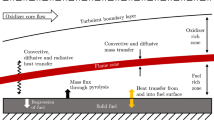Abstract
To study combustion chemistry at low temperatures in a shock tube, it is of great importance to increase experimental test times, and this can be done by tailoring the interface between the driver and driven gases. Using unconventional driver-gas tailoring with the assistance of tailoring curves, shock-tube test times were increased from 1 to 15 ms for reflected-shock temperatures below 1,000 K. Provided in this paper is the introduction of tailoring curves, produced from a one-dimensional perfect gas model for a wide range of driver gases and the production and demonstration of successful driver mixtures containing helium combined with either propane or carbon dioxide. The He/CO2 and He/C3H8 driver mixtures provide a unique way to produce a tailored interface and, hence, longer test times, when facility modification is not an option. The tailoring curves can be used to guide future applications of this technique to other configurations. Nonreacting validation experiments using driver mixtures identified from the tailoring curves were performed over a range of reflected-shock temperatures from approximately 800 to 1,400 K, and some examples of ignition-time experiments that could not have otherwise been erformed are presented.
Similar content being viewed by others
References
Anderson J.D. (2003) Modern Compressible Flow, 3rd edn. McGraw-Hill, NewYork
Petersen E.L., Rickard M.J.A., Crofton M.W., Abbey E.D., Traum M.J., Kalitan D.M. (2005) A facility for gas- and condensed-phase measurements behind shock waves. Meas. Sci. Tech. 16:1716–1729
Roshko A. (1960) On flow duration in low-pressure shock tubes. Phys. Fluids 3, 835–842
Hooker W.J. (1961) Testing time and contact-zone phenomena in shock-tube flows. Phys. Fluids 4:1451–1463
Rudinger G. (1961) Effect of boundary-layer growth in a shock tube on shock reflection from a closed end. Phys. Fluids 4:1463–1473
Mirels H. (1963) Test time in low-pressure shock tubes. Phys. Fluids 6:1201–1214
Brabbs, T.A., Belles, F.E.: Contact-Surface Tailoring in Real Shock Tubes. In: Proceedings. 5th International. Shock Tube Symposium, pp. 955–968 (1965)
Dumitrescu L., Popescu C., Brun R. (1970) Experimental Studies of the Shock Reflection and Interaction in a Shock Tube. In: Glass I. (eds) Shock Tubes. Proceedings of the 7th International Shock Tube Symposium, University of Toronto Press, Toronto, pp. 751–770
Petersen, E.L., deVries, J.: Measuring the ignition of fuel blends using a design of experiments approach. AIAA Paper 2005-1165 (2005)
Tsuboi, T., Nagaya, K.: Study on dependence of thermal radiation energy of liquid spray flame on pressure and temperature. In: Shock Tubes and Waves. Proceedings of the 16th International Symposium on Shock Tubes and Waves. pp. 503–509 (1987)
Ciezki H.K., Adomeit G. (1993) Shock-tube investigation of self-ignition of n-heptane-air mixtures under engine relevant conditions. Comb. Flame 93, 421–433
Cadman P., Thomas G.O., Butler P. (2000) The autoignition of propane at intermediate temperatures and high pressures. Phys. Chem. Chem. Phys. 2:5411–5419
Herzler J., Jerig L., Roth P. (2005) Shock tube study of the ignition of lean n-heptane/air mixtures at intermediate temperatures and high pressures. Proc. Comb. Inst. 30:1147–1153
Lu F.K., Wilson D.R., Bakos R.J., Erdos J.I. (2000) Recent advances in detonation techniques for high-enthalpy facilities. AIAA J. 38:1676–1684
Erdos, J.I., Bakos, R.J., Castrogiovanni, A., Rogers, R.C.: Dual mode shock-expansion /reflected-shock tunnel. AIAA Paper 1997-560 (1997)
Gaydon A.G., Hurle I.R. (1963) The Shock Tube in High-Temperature Chemical Physics. Rienhold, New York
Glass I.I., Sislian J.P. (1994) Nonstationary Flows and Shock Waves. Clarendon, Oxford
Nishida M. (2001) Shock Tubes. Handbook of Shock Waves, vol. 1. Academic, Newyork
Kee, R.J., Rupley, F.M., Miller, J.A.: The Chemkin Thermodynamic Database. SAND87-8215B, Sandia National Laboratory (1990)
Petersen E.L., Kalitan D.M., Rickard M.J.A. (2004) Reflected-shock ignition of SiH4/H2/O2/Ar and SiH4/CH4/O2/Ar mixtures. J. Prop. Power 20, 665–674
Hall, J.M., Petersen, E.L.: An optimized kinetics model for OH chemiluminescence at high temperatures and atmospheric pressures. Int. J. Chem. Kinet. (in press, 2006)
deVries, J.: An Investigation of the Autoignition of Power Generation Gas Turbine Fuel Blends Using a Design of Experiments Approach. M.S. Thesis, University of Central Florida (2005)
Author information
Authors and Affiliations
Corresponding author
Additional information
Communicated by R. K. Hanson.
Rights and permissions
About this article
Cite this article
Amadio, A.R., Crofton, M.W. & Petersen, E.L. Test-time extension behind reflected shock waves using CO2–He and C3H8–He driver mixtures. Shock Waves 16, 157–165 (2006). https://doi.org/10.1007/s00193-006-0058-6
Received:
Revised:
Accepted:
Published:
Issue Date:
DOI: https://doi.org/10.1007/s00193-006-0058-6




